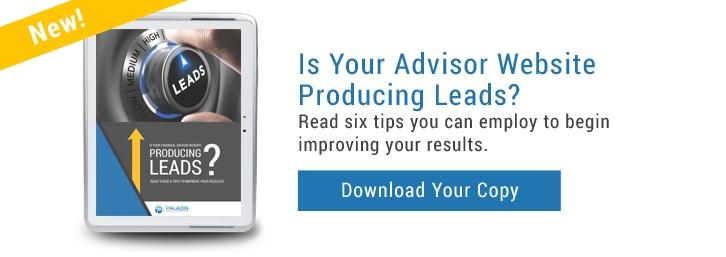Are Financial Advisor Websites Just Online Brochures?
Financial advisor websites are in a state of transition from online brochures to optimized, lead generation websites.
1997
20 years ago, financial advisor collateral material was an eight-page firm brochure that described company history, teams of professionals, services, and unique benefits. Everyone had brochures because they were conspicuous if they did not have them.
2007
10 years later the Internet took-over. Financial advisor websites were the new delivery system for information about firms and professionals. It was an easy transition when companies transferred the images and content in their brochures to their websites. Everyone had websites because they were conspicuous if they did not have them.
2017
Today, there is a new marketing paradigm. Investors who use the services of financial advisors have access to an infinite number of choices and information at their fingertips.
They use the Internet to find financial advisors and research them. They visit websites, Google search names, and visit third party websites. They expect to find information that will help them determine who they want to contact.
Online sales brochures that use generic content and stock photos don’t work anymore. This means financial advisor websites must evolve to meet investor expectations and their buying habits.
Online Brochure or Lead Generation Website?
How do financial advisors know if they have online sales brochures or lead generation websites?
They should ask one simple question. How many qualified leads do their websites produce each month? If the answer is none or very few then there is a good chance the websites are attractive brochures that are accessible on the Internet.
Website Content
Advisor websites should have a limited amount of content about the firm so it can provide more content about the needs and concerns of investors.
- Investors want to know which advisory firms understand their financial needs and concerns the best?
- Do the advisory firms provide the services that investors think they need to achieve their most important financial goals?
- How do financial advisory firms stand-out in a very crowded field?
Investors who visit websites must feel a connection so they know they came to the right place.
The ultimate challenge is time. Typical investors spend three minutes or less on advisor websites. Advisors must provide the right information using intuitive navigation and short sound-bites.
Investor Education
In 2017, investors use the Internet to learn-more about financial advisors before they initiate contact with the firms and professionals that provide the services they are seeking.
Why is learn-more a critical element? The content on advisor websites must match the interests of potential clients.
Advisors are missing the boat if their websites do not provide free educational content about financial firms and the various types of professionals.
Most often this is done in the form of an eBook, white paper, or info-graphic.
Financial advisors are providing the information that investors need to make the right decisions when they select firms and professionals. At the same time, they are educating them to select the firm that provided the content.
Websites that tell investors the truth are more trustworthy than firm websites that withhold information. This will become increasingly important as more financial firms practice transparency.
Keyword Rich Websites
Websites need traffic to produce leads. Traffic occurs when investors visit websites. However, it is more likely investors will find advisor content before they find the advisors’ websites.
It is imperative that financial advisors know the keywords that investors input in search engines when they are seeking information and professional help for their assets.
- Which keywords produce the most traffic?
- How competitive are the keywords?
- What content will produce the greatest amount of visibility for those keywords?
Success means advisors are increasing the number of organic visitors to their websites each month.
A great site can be a lot like an exceptional restaurant that no one knows about. Word of mouth can take years. Finding it on the Internet with some great reviews is the key to success.
Advisors need great websites that are optimized for the Internet and multiple Inbound Marketing strategies to be successful on the Internet.
Advanced website analytics help advisors track the performance of their sites. Any weaknesses on the sites, for example pages with high bounce rates, should be corrected as soon as possible.
Website Conversion Rates
Too many financial advisors still look at websites the way they looked at their firm’s brochures. The brochure was a way to communicate static firm information in an attractive package.
Advisor websites are never static. They change monthly or quarterly to improve their ability to convert traffic into qualified leads for the firms’ services.
What changes? Page content, CTAs, free offers, white papers, and landing pages are constantly changing to maximize website conversion rates.
How do advisors know what to change? The advanced analytics produce reports that are reviewed monthly to identify weaknesses that undermine the performance of websites. Weaknesses are dealt with to improve the performance of financial advisor websites.
How Many Leads?
How many leads should financial advisor websites produce each month?
A conservative estimate is 1% of your visitors should initiate contact by telephone, email, or subscribing to a free offer.
For example, a site with 1,000 visitors per month should produce 10 leads. Some of the leads may be seeking information. Other leads are seeking financial advisors. Advisory firms want both types of leads – information seekers are future clients.
Information seekers go into advisors’ CRM systems. Marketing staffs should respond to active leads the same day or no later than the next business day. Advisory firms spend a lot of time and money producing warm leads. None should slip through the cracks.


